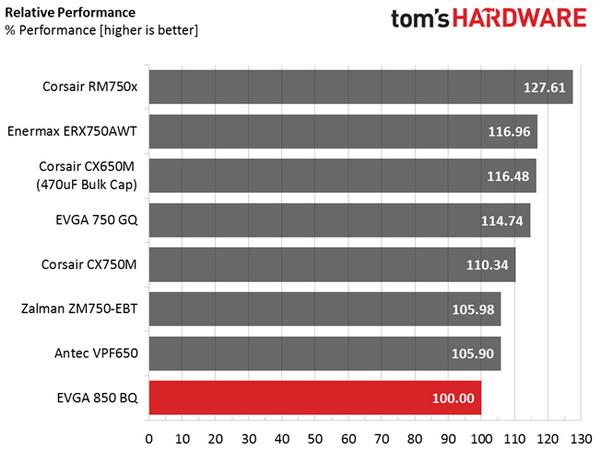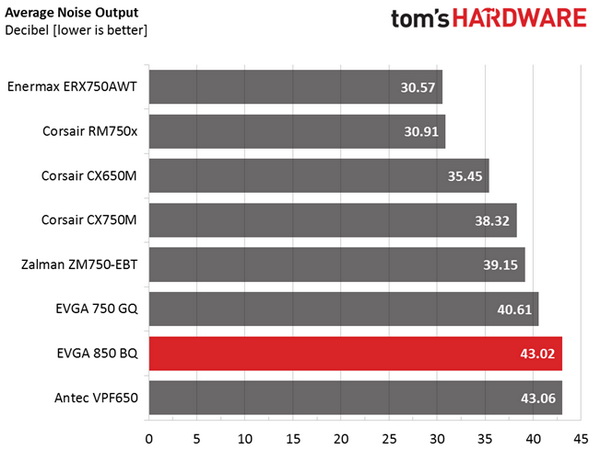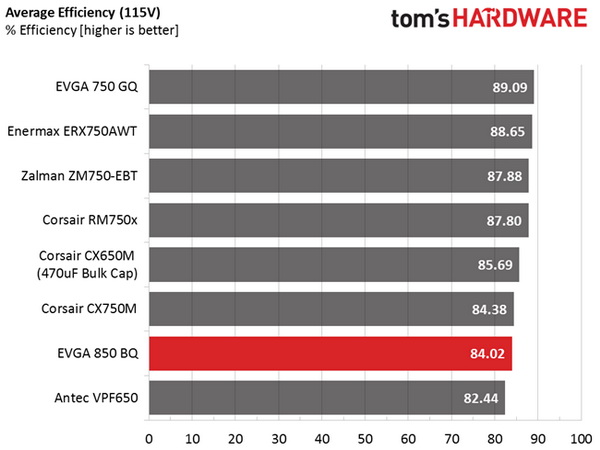EVGA BQ Series 850W PSU Review
One of EVGA's most affordable power supply families, the BQ, includes five unique models. The higher-capacity ones are made by HEC and the rest come from Andyson. Today we're testing the flagship 850 BQ.
Why you can trust Tom's Hardware
Performance, Performance Per Dollar, Noise, And Efficiency Ratings
Performance Rating
The following graph illustrates the 850 BQ's total performance rating, comparing it to other units we have reviewed. To be more specific, the tested unit is shown as 100 percent, and every other unit's performance is shown relative to it.
EVGA's overall relative score is pretty low, mostly because of loose load regulation and increased ripple on the minor rails, along with the 3.3V rail's poor response to transient loads.
Performance Per Dollar
The following chart may be the most interesting to many of you because it depicts the unit's performance-per-dollar score. We looked up the current price of each PSU on popular online shops and used those prices and all relative performance numbers to calculate the index. If the specific power supply wasn't available in the United States, we searched for it in popular European Union shops, converting the listed price to USD (without VAT). Note that all of the numbers in the following graph are normalized by the rated power of each PSU.
EVGA's asking price is pretty affordable, so the 850 BQ's performance per dollar score is only a little lower than the CX750M's.
Noise Rating
The graph below depicts the cooling fan's average noise over the PSU's operating range, with an ambient temperature between 28°C and 30°C (82°F to 86°F).
The 850 BQ is noisy, no doubt about it. This is a great shame because, with a lower minimum fan speed, it could be much quieter.
Efficiency Rating
The following graph shows the PSU's average efficiency throughout its operating range, with an ambient temperature between 28°C and 30°C.
Get Tom's Hardware's best news and in-depth reviews, straight to your inbox.
Efficiency lands in the 80 PLUS Bronze region, unsurprisingly. If you need higher efficiency, then you have no other option but to invest in a Gold-rated unit. Of course, that's going to cost more, too.
Current page: Performance, Performance Per Dollar, Noise, And Efficiency Ratings
Prev Page Ripple Measurements Next Page Pros, Cons, And Final Verdict
Aris Mpitziopoulos is a contributing editor at Tom's Hardware, covering PSUs.
-
Metteec Also, for $20 more, you can pick up an equivalent gold rated PSU or maybe even a platinum one on sale and after rebates. It is the halcyon days for competition in quality PSUs.Reply -
_TheD0ct0r_ Reply19020704 said:Thanks for the review. Looks like I will be avoiding this one.
Why is that?
-
Metteec @_THEDICTOR_, for $85, there are so many other better options. EVGA could have been more competitive model if they made quieter version. Instead, you get a PSU with fixed cables, low efficiency, high power variances, and noise like a mini-vacuum. While the higher quality capacitors and warranty are nice, the lack of utility does not make this a good value. 3-years ago, this would have been a great PSU, but times have changed. It is a great day to buy a PSU, just not this one.Reply -
MasterMace appears to be another terrible unit. I'll have to read back and see if it's an Andyson or a HECReply -
Nuckles_56 I would have thought that EVGA could have pushed HEC a bit harder and got a much better unit out of them than thisReply -
lunyone I would personally like to see more 450-550w PSU reviews, not the cherry picked and delivered 750w+ ones that seem to make the rounds. It is just that most people are only going to need 450-550w PSU's for their 1 dGPU based systems.Reply -
Aris_Mp This is not a cherry-picked sample. It comes directly from a store shelf and not from EVGA.Reply
As for more 450-550W PSU reviews, I am currently working on a 500W unit (which however isn't affordable).



